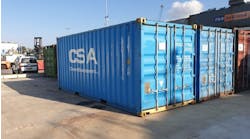Saipem is preparing to install novel pipeline support structures on ExxonMobil’s Kizomba Satellites project off Angola. The Ez-Crossings have been designed by Bardot Group to provide a lower cost, low friction, abrasion-resistant method to allow pipeline crossing over long distances. These HDPE-extruded tubes with a different configuration and lower diameter are also used as pipeline buckling mitigation instead of conventional distributed buoyancy modules (DBMs).
The company, a subsea engineering specialist based in La Ciotat, southern France, had previously proposed these devices to Technip for the installation of Chevron’s Jack/St. Malo pipeline. But engineering was too advanced at that point to consider an alternative and the client decided to stick with DBMs.
Artist’s impression of a pipeline supported by two Ez-Sleepers.
For Saipem, however, there were numerous attractions, notably the ease of installation.
Ez-Crossings and Ez-Sleepers are high- density polyethylene tubes with integrated ballast that can be transported to the offshore location by a conventional boat and transferred to a supply vessel. The tubes arrive fully assembled, so no on-deck firing line is required. They are then lowered to the seabed using a simple spreader bar off the critical path of the pipelay vessel. The pipe or flowline is laid on top of the Ez-Sleepers or Ez-Crossing.
For Ez-Sleepers, dimensions can be varied, depending on lateral buckling predictions – Bardot Group works with near neighbor Principia on analytical and practical engineering. Exact configuration – size and spacing – is determined by specific lateral buckling FEA models.
Bardot Group claims other advantages. For DBMs, qualification and testing for an offshore project are more onerous, including hydrostatic creep and chemical/oxidation aging of the syntactic foam, and wet/dry friction against insulation coating for the internal elastomeric pad. Fewer tests are required for the well-qualified, standard HDPE employed for the Ez-Sleeper tubes. Both systems must undergo axial load, lateral load, and static impact tests, as well as abrasion testing, but in the latter case qualification is easier for the Ez-Sleeper due to its lower friction ratio of 0.1 (Pipe/Ez-Sleeper).
The friction issue means that heavy, abrasion-resistant materials must typically be applied to protect DBMs, adding to the overall cost. Bardot Group claims that the buoyancy volume needed to match a buckling solution provided by 100 Ez-Sleepers is nearly twice as high, at $6.2 million. Another advantage of this low friction compared to other mitigation measures is that it avoids pipeline coating damage.
For the Kizomba Satellites project, Bardot Group commissioned two specially-designed machines for the assembly/welding process. Unlike competitors such as Balmoral and Trelleborg, it does not have its own production site. Instead, it qualifies partners to produce its systems, currently working with companies in Brazil, Houston, and Valence in France (the next step is to develop a partnership for the Asia-Pacific region in Malaysia or Singapore).
Pipelife in Norway was asked to produce the HDPE tubes for the Ez-Crossings with a thickness of over 80 mm – the norm for this material, Guy Bardot says, is nearer 40-50 mm. “The extra thickness is needed to guarantee the wall lifetime. Polymers are susceptible to a creeping phenomenon: they become ovoid, and very thick tubes are therefore needed to ensure that the material retains its dimensions throughout the life-span of the pipeline.”
Following extrusion and cooling, the resultant 12-m sections were heavy, weighing 230 kg/m. Concurrently, Bardot Group hired a company in Antwerp and supervised the whole carbon steel ballast assemblies to go inside the tubes. Earlier this year, all completed components were shipped to Luanda for welding at Saipem’s construction yard to create 60-m long crossing supports. After production qualification, there should be two months of assembly followed by installation in July or August on Kizomba in Angolan block 15, in a water depth of 800 m.
Bardot Group is now trying to interest other pipelay contractors. It has approached Subsea7 concerning Inpex’s Ichthys project, which involves subsea pipeline installation over 300 km long. The group is also establishing a small EPCI company called DTS (Direct to Shore). “The large EPCI contractors are increasingly looking to subcontract the smaller pipelay packages in their contracts,” Bardot explains, “in the range $5-20 million. We would look to rent a vessel to lay pipe on the seabed or put in platform tiebacks, and these could be supported by Ez-Sleepers.”
More Offshore Issue Articles
Offshore Articles Archives
View Oil and Gas Articles on PennEnergy.com




